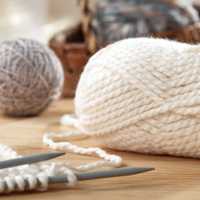Be Happy...Be Knitting!
By Alice Seidel
Be Happy...Be Knitting!
By Alice Seidel
Life is good. We need to always remember that. Do something worthwhile. Learn to knit.
Of course, when learning to knit, one of the first things you need to figure out is how to hold the needles.
Knitters, no matter where they live, all knit in the same fashion. The only difference is how you hold the yarn, and in what hand.
There are two basic ways in which to knit. One is the English (or American) way, and the other is the Continental way.
To begin knitting in the English method, hold the right needle as you would a pencil. The left needle gets held between your left thumb and index finger so as to control the stitches.
Some knitters like to knit close to the tip of the needle, while others prefer the safety of keeping the stitches further back on the needles. Either way is fine.
In fact, some projects are easier to work close to the tip than others. You will find this out with the more patterns you knit.
Your preference, your control, is what works for you! That's the beauty of knitting; finding your own way. A little bit like life.
Keep in mind the word "loose" at all times, when casting on. It really does help. And you do want that foundation row to be pliable enough to work with.
When you start to knit, hold the needles lightly, and don't let the stitches become too cramped or tight. If you are new to knitting, this will probably happen. Just unravel, and start again.
Knitting should flow easily. Oh yes, there are those chunky, bulky yarns that are difficult to work with, so they will require greater strength from you as you progress, but that is normal to that particular yarn.
Nothing should be so tight as to be impossible to work off the needle. If that happens, just go back and try again. And again. And, maybe, even again.
As you progress, remember to control your yarn and stitches with your right index finger. Or you may use several fingers for control. This is relevant to keeping all stitches on the needle. Especially as you learn to include stitches beyond "knit and purl", such as "yo" or "k2tog" or increasing. You don't want to start dropping stitches or losing them from row to row.
You know the deal; you cast on 43 stitches and by the sixth row you have maybe 39, so where did the other four stitches go?
Remember, there is no one method that is 100% correct; if something works for you, then stick with that.
Be mindful when making stitches; keep a steady hand on your needles, but don't grip them so tightly that you can't knit a stitch.
Relax! It's only yarn.
Knitting should become confortable to you, and in the beginning, it won't feel that way. That's normal, too. Only with lots of practice will you begin to form your own unique approach to knitting!
When you attain that, knitting will be so easy to do, and ideas will pop into your head all the time, ideas that you can transfer to your knitting needles for creations like no other!
For you will have found a gift, a gift which you can bring to the world! You see, in the yarn we knit is the invisible thread which weaves us all... one to another.
Copyright 2006 Alice Seidel
In less than a weekend, you can learn to knit -- FAST and EASY! The place where smart knitters go! Cutting-Edge Ebook, free patterns, newsletter ==> Website: http://www.theknitstitch.com/
Article Source: http://EzineArticles.com/?expert=Alice_Seidel
Life is good. We need to always remember that. Do something worthwhile. Learn to knit.
Of course, when learning to knit, one of the first things you need to figure out is how to hold the needles.
Knitters, no matter where they live, all knit in the same fashion. The only difference is how you hold the yarn, and in what hand.
There are two basic ways in which to knit. One is the English (or American) way, and the other is the Continental way.
To begin knitting in the English method, hold the right needle as you would a pencil. The left needle gets held between your left thumb and index finger so as to control the stitches.
Some knitters like to knit close to the tip of the needle, while others prefer the safety of keeping the stitches further back on the needles. Either way is fine.
In fact, some projects are easier to work close to the tip than others. You will find this out with the more patterns you knit.
Your preference, your control, is what works for you! That's the beauty of knitting; finding your own way. A little bit like life.
Keep in mind the word "loose" at all times, when casting on. It really does help. And you do want that foundation row to be pliable enough to work with.
When you start to knit, hold the needles lightly, and don't let the stitches become too cramped or tight. If you are new to knitting, this will probably happen. Just unravel, and start again.
Knitting should flow easily. Oh yes, there are those chunky, bulky yarns that are difficult to work with, so they will require greater strength from you as you progress, but that is normal to that particular yarn.
Nothing should be so tight as to be impossible to work off the needle. If that happens, just go back and try again. And again. And, maybe, even again.
As you progress, remember to control your yarn and stitches with your right index finger. Or you may use several fingers for control. This is relevant to keeping all stitches on the needle. Especially as you learn to include stitches beyond "knit and purl", such as "yo" or "k2tog" or increasing. You don't want to start dropping stitches or losing them from row to row.
You know the deal; you cast on 43 stitches and by the sixth row you have maybe 39, so where did the other four stitches go?
Remember, there is no one method that is 100% correct; if something works for you, then stick with that.
Be mindful when making stitches; keep a steady hand on your needles, but don't grip them so tightly that you can't knit a stitch.
Relax! It's only yarn.
Knitting should become confortable to you, and in the beginning, it won't feel that way. That's normal, too. Only with lots of practice will you begin to form your own unique approach to knitting!
When you attain that, knitting will be so easy to do, and ideas will pop into your head all the time, ideas that you can transfer to your knitting needles for creations like no other!
For you will have found a gift, a gift which you can bring to the world! You see, in the yarn we knit is the invisible thread which weaves us all... one to another.
Copyright 2006 Alice Seidel
In less than a weekend, you can learn to knit -- FAST and EASY! The place where smart knitters go! Cutting-Edge Ebook, free patterns, newsletter ==> Website: http://www.theknitstitch.com/
Article Source: http://EzineArticles.com/?expert=Alice_Seidel



